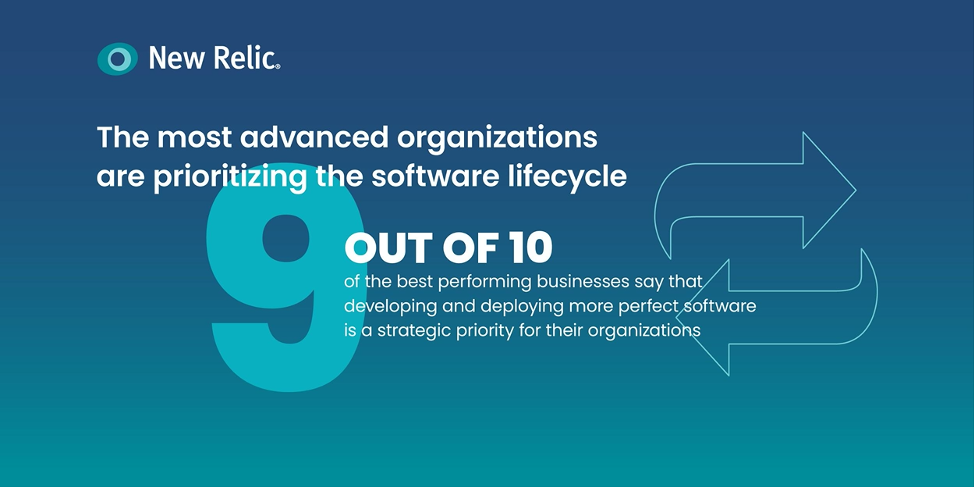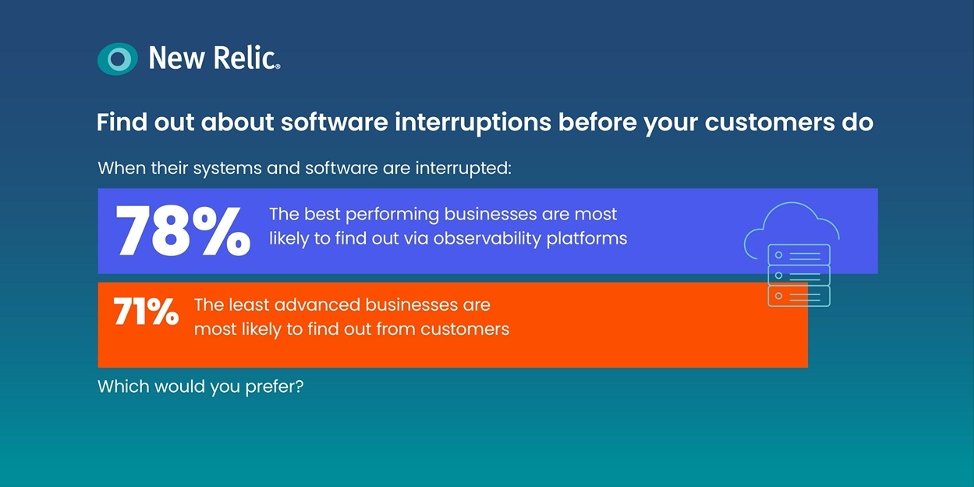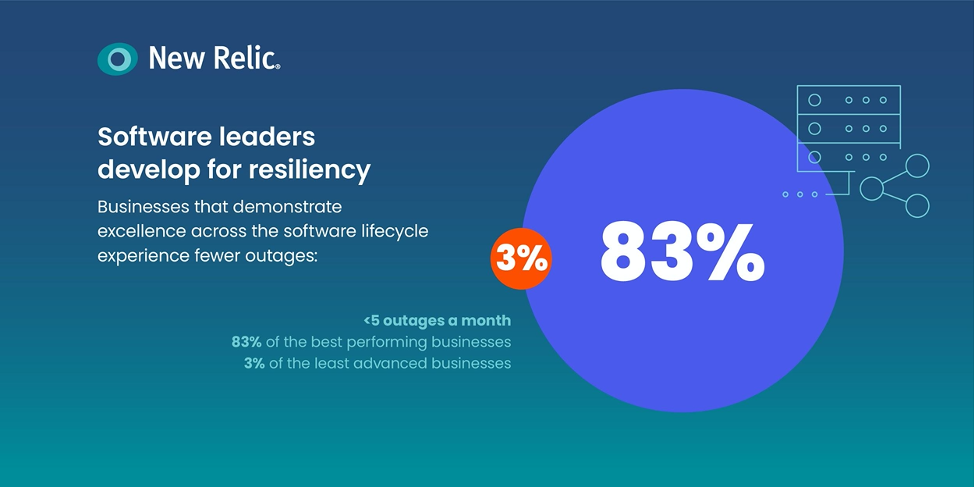Managing software and optimizing its performance have become, in this age of digital transformation, essential to business competitiveness and survival. Now more than ever, software excellence is synonymous with business success, and it’s the reason part of New Relic’s mission is to “help our customers create more perfect software.”
But what does that phrase “more perfect software” really mean? And how do companies deliver on it so that they outcompete in their markets? Those questions led us to conduct research surveying hundreds of software professionals around the globe to determine how companies are prioritizing, developing, and optimizing great software; how it benefits their businesses; and what software leaders do differently versus organizations that lag behind.
You’ll find the full results in our new report, Deeper Than Digital: Why and How More Perfect Software Drives Business Success. Within it, you’ll learn the difference between an industry leader and an industry laggard when it comes to developing, monitoring, and managing more perfect software—as well as the countries that are pulling ahead. You’ll also have the opportunity to benchmark where your company stands compared with the leaders.
Software development leaders vs. laggards
More perfect software and systems are developed and maintained in a way that makes it easy for engineering teams to quickly understand, improve, and iterate upon the end user experience without disruption. More perfect software is built that way from inception, and as a result, it can withstand a degree of failure that won’t cause expensive catastrophes. That resilience provides the confidence your teams need to innovate with speed and agility.
At New Relic, we believe delivering more perfect software requires progress against five pillars, which we discuss in detail below. The top 25% of our research respondents who report excellent progress against these imperatives are not only identified as “More Perfect Software Leaders,” but they also report higher success against business metrics like financial performance and growth, pace of innovation, employee engagement, and brand perception. These are the companies at which 90% of the respondents claimed “developing and deploying more perfect software—which is dynamic, resilient, and critical to delivering outstanding customer experiences—is a top priority for their organization.” Conversely, the 25% of companies making the least headway on these five pillars are lagging behind their peers in nearly all categories.
The five pillars of more perfect software
Excelling in software development, performance optimization, and life cycle management requires companies to meet five imperatives. The organizations that are becoming experts in these pillars are seeing stronger revenue growth, fewer software and systems outages, and a faster pace of innovation.
1. Cloud maturity
Companies must be actively leveraging cloud technology to gain the speed, agility, efficiency, and scalability they need to build more perfect software. The average respondent to our research runs 56% of their software and systems in the cloud, but more than half say it will be four years before they are 75% in the cloud.
Among other findings:
- 66% of leaders are running software in the cloud compared with 46% of laggards.
- 96% of leaders have adopted a cloud native approach to software development compared with 24% of laggards.
The barriers to cloud migration for leaders vs. laggards also differ: Leaders cite security concerns (66%), needing to comply with regulations (53%), and ‘sunk’ investment in on-premises infrastructure as their top three concerns. Laggards, on the other hand, say their top three barriers include a lack of the skills required to migrate software to the cloud (46%), tied with ‘sunk’ investment in on-premises infrastructure (46%), security concerns (45%), and cultural issues, such as resistance to change or siloed thinking (43%).
2. Observability mastery
Observability is one of the key tenets of more perfect software, but our research findings revealed some confusion around the term. We defined it as “automatically monitoring in real time all software and infrastructure performance data—metrics, events, logs, and traces—to rapidly deliver a complete understanding of an IT stack’s operation and performance.” Even though 67% of respondents agree their organization has a real-time view of how all systems are performing and interacting on a single platform, only 8% of them rate as “very good” their ability to know why issues occur and three-quarters are unhappy with their mean time to resolution (MTTR).
This begs the question about whether respondents are really practicing observability if such a low percent of them know why issues occur.
The leaders know the importance of observability: 94% say it is key to developing software—not just something added on after the fact. Just 56% of the laggards say the same. Leaders also report higher levels of observability: 78% find out about system and software interruptions via observability solutions, compared with just 12% of laggards, who more often learn about interruptions from employees (71%) or manual checks (63%). What’s more, nearly 79% of laggards say a lack of observability is a major barrier to improving business performance, compared with just 12% of leaders.
3. End-to-end data visibility
Complete observability depends on collecting as much telemetry data as possible from all software and systems, but our research found that respondents—on average—have instrumented less than half of their IT systems. More Perfect Software Leaders have instrumented significantly more and are collecting data from 58% of their software and systems, whereas the laggards instrument just 42%.
Integrating data on software and systems performance with data on end-user performance across platforms is another factor that sets leaders apart from laggards. Firms that integrate telemetry data in this way are able to understand rapidly how changes to software affect customers and overall business performance. And, according to our research, 99% of leaders have the ability to quickly understand the results of changes to software (because 100% of them integrate their data) compared with 38% of laggards (only 20% of which claim to integrate data).
Other cited benefits of collecting and integrating telemetry data are better collaboration between teams, the ability to fix issues more quickly because you can actively infer where issues are and why they exist, and knowing how to identify opportunities to develop new products or improve upon existing ones.
4. Digital resilience
More perfect software has to be developed with architectural resilience in mind to give development teams confidence that their changes won’t result in catastrophic failure. This ability to deliver with confidence provides developers a stable platform for innovation. Building up resilience through chaos testing and automated remediation also results in fewer major software and systems outages. Among the findings:
- 77% of leaders have adopted chaos testing, compared with just 30% of laggards.
- 89% of leaders engage in automated remediation in contrast with just 5% of laggards.
With these systems in place, 83% of leaders experience five software and systems outages per month, while 49% of laggards experience 11 to 15.
5. Free-to-thrive teams
The last pillar for more perfect software focuses on how software and systems teams work—whether they have autonomy to make quick decisions, whether they’re empowered with observability technology, whether they can make decisions without fear of repercussion, and more. These qualities are the hallmarks of a DevOps culture that encourages speed and drives efficiency, optimal productivity, and high job satisfaction. In this case, the data is perfectly clear: 99% of leaders say the combination of their organization’s culture and observability technology allows their developers to make quick decisions without fear of repercussions. Just 33% of laggards can say the same.
Similarly, the leaders spend, on average, 77% of their time innovating (versus fixing issues), while the laggards spend just 54% innovating. And when it comes to satisfaction around the amount of time it takes to identify and fix issues, there’s even greater disparity: 56% of leaders say they are unhappy with the rate at which they can discover and resolve software problems, but a whopping 89% of laggards claim the same.
The foundation of digital excellence
The five pillars of more perfect software form the foundation of digital excellence, and organizations in all industries can benefit from strengthening their capabilities. Whether you’re a leader, laggard, or somewhere in between, New Relic wants to help push your customer-facing experiences to new heights, while releasing your engineers from the burdens of firefighting.
To dive deeper into our findings, benchmark your organization’s progress, and discover key lessons from the More Perfect Software Leaders, explore our full report.
The views expressed on this blog are those of the author and do not necessarily reflect the views of New Relic. Any solutions offered by the author are environment-specific and not part of the commercial solutions or support offered by New Relic. Please join us exclusively at the Explorers Hub (discuss.newrelic.com) for questions and support related to this blog post. This blog may contain links to content on third-party sites. By providing such links, New Relic does not adopt, guarantee, approve or endorse the information, views or products available on such sites.






